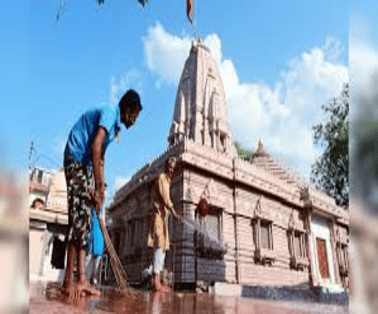The Karnataka Cabinet recently passed the controversial ‘Temple Bill’, which will now be sent to the governor for his assent, following which it will become law. This bill aims to change the taxation system of Karnataka temples and reallocate funds for welfare purposes.
Key Points of Karnataka’s Temple Bill
- Siddaramaiah-led Congress government tabled the Karnataka Hindu Religious Institutions and Charitable Endowments (Amendment) Bill, 2024 on 21 February and was passed in the Vidhan Sabha.
- However, on 23 February the proposed bill was defeated by a voice vote in the upper house where the opposition has a majority.
- Karnataka’s Temple Bill was reconsidered and it has now received the green light in both Assembly and Legislative Council.
- The council passed the bill it had rejected amidst a din, as opposition BJP and JD(S) members protested in the house against the government over the alleged pro-Pakistan slogans chanted in the assembly.
- The Bill, aimed to alter the taxation of Hindu temples.
What is the Karnataka Temple Bill?
- The Karnataka Hindu Religious Institutions and Charitable Endowments (Amendment) Bill, 2024 proposes to collect 5% from temples whose gross income is between ₹10 lakh and less than ₹one crore.
- And, for temples whose annual income is above ₹1 crore, the state government will collect 10% of the funds. These funds will be put into a Common Pool Fund, administered by ‘Rajya Dharmika Parishath’.
- The Common Pool Fund is proposed to be used for the welfare of archakas/priests (like insurance cover, death relief fund, and scholarship to children from families of around 40,000 priests and other employees) and the upkeep of ‘C’ category temples (state-controlled) whose annual income is less than ₹5 lakh.
- The common fund pool was created in 2011, by amending the 1997 Act.
- The Department of Religious and Charitable Endowments, popularly known as the Muzrai department administers about 35,000 Hindu religious institutions which receive grants from the Government of Karnataka.
Other Key Details of the Karnataka Temple Bill
- The Bill suggests adding a member skilled in Vishwakarma Hindu temple architecture and sculpture to the “committee of management” of temples and religious institutions.
- Under Section 25 of the KHRI& CE 1997 Act, temples and religious institutions are required to form a “committee of management” consisting of nine people, including a priest, at least one member of a Scheduled Caste or Scheduled Tribe, two women, and one member of the locality of the institution.
- The Bill empowered the Rajya Dharmika Parishat to appoint committee chairpersons and handle religious disputes, temple statuses, and trustee appointments.
- Additionally, it mandated the creation of district and state committees to oversee infrastructure projects for temples earning over Rs 25 lakh annually.
Status of Temples in Karnataka
- There are around 35,000 temples under the Muzrai Department, of which 205 are Group A – whose income exceeds Rs 25 lakh per year
- 193 are Group B – with incomes between Rs 5-25 lakh and around 34,000 are Group C – with incomes below Rs 5 lakh.
- Till date, Group A temples contributed 10 per cent of the revenue generated from collection boxes to a Central Fund and Group B contributed five per cent. There were no contributions from Group C temples.
Controversy Surrounding the Karnataka Temple Bill
- The opposition- Bhartiya Janata Party (BJP) and Janata Dal (Secular) have called the bill anti-Hindu. They argue that the Congress government in Karnataka was trying to fill its “empty coffers” with temple money.
- Some opposition leaders also said that the Siddaramaiah government would divert the revenue from temples to other religions.
- However, Minister of Muzrai Ramalinga Reddy said that BJP was “politicising” the bill by linking it with “communal theory”.
- Previously, temples with annual income between ₹5 lakh and ₹10 lakh used to give 5% of their net income to the Common Pool Fund, and temples with an annual income of over ₹10 lakh used to give 10% of the net income into the fund.
Revenue Collection Systems for Temples in Other States
- In Telangana, religious institutions making more than ₹50,000 annually are required to pay 1.5% of their annual income to the state government.
- Under Section 70 of the Telangana Charitable and Hindu Religious Institutions and Endowments Act, 1987, the Commissioner in charge of administration of religious institutions can create a “Common Good Fund”.
- In Kerala, temples are managed by state-run Devaswom (temple) Boards.
- The state has five autonomous Devswom Boards that manage over 3,000 temples. These boards are run by nominees appointed by the ruling government, who are often politicians.
- Each Devaswom Board has a budget allocated by the state government and is not required to share revenue figures
- In Uttarakhand, 51 temples and shrines including Badrinath, Kedarnath, Yamunotri, and Gangotri were freed from the state government’s control in 2021
To Download Monthly Current Affairs PDF Click here
Click here to get a free demo
Discover all about CLAT Exam



